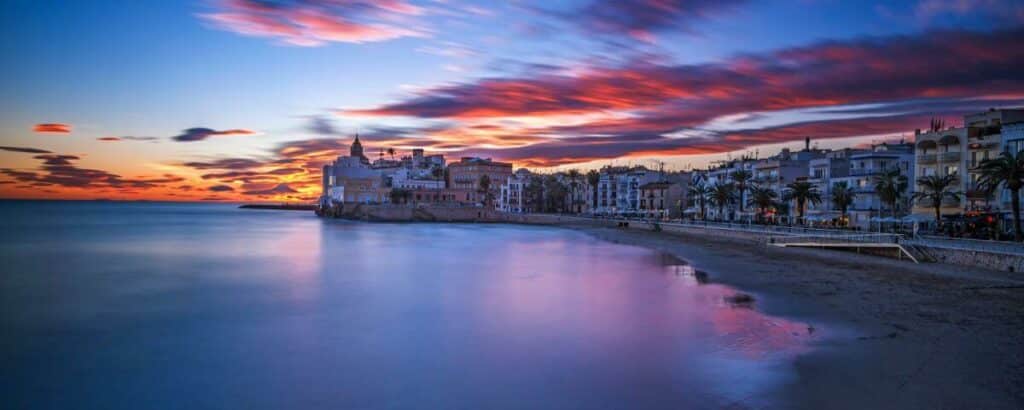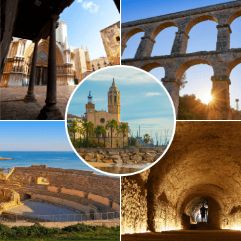
How to get to Sitges from Barcelona
ALL ABOUT GETTING TO BARCELONA FROM SITGES
Sitges is a beautiful seaside village located 40km (25 miles) South-West of Barcelona. It is famous for its beaches, its modernist heritage (here the painter Santiago Rusiñol organized the first Modernist Festivals that would evolve into a golden age in Barcelona. Sitges is also a relaxed gay resort, while keeping a family-friendly feel. It’s also an active cultural destination organizing international festivals (horror movies, tango dancing…), as well as popular traditional events such as their colorful Carnival or the flower carpets during Corpus Domini.

Sitges was traditionally a fishing town, and its inhabitants were natural sailors that explored the Mediterranean sea and even travelled to America across the Atlantic ocean. So the sea was for centuries one of its main communication systems. Then in 1881, the railway arrived to Sitges connecting the village with Barcelona. Then with the Olympic Games of 1992, the construction of the Garraf Tunnels made the connection Barcelona-Sitges what it is today.
1
Getting to Sitges by car
Driving to Sitges takes around 45 minutes. You’ll leave the city either from the Ronda Litoral or the Ronda de Dalt towards Llobregat, or Gran Via de les Corts Catalanes towards Tarragona, and from there you’ll take either the C-31 (Autovia de Castelldefels) or the C-32. Then right before entiring the Garraf mountains you’ll have to choose if you want to pay for the Garraf Tunnels or continue via de C-31 (Carretera de les Costes del Garraf).
The Tunnels cover some 10 km (6 miles) and comprise 5 tunnels. They are known to be one of the most expensive tolls in Spain, but there’s discounts available for residents, as well as vehicles with 3+ occupants and during off-peak hours. The Tunnels lead to the Autopista Pau Casals (C-32) that passes Sitges on its way to Tarragona and the South of Spain. The highway exits are “Aiguadolç Port – Sitges Nord”, “Sitges Centre” (via Passeig Vilafranca), “Sant Pere de Ribes Est” (towards Avinguda Sofia) and “Sant Pere de Ribes Sud” (to reach the Terramar neighborhood).
Instead, the Costes del Garraf road is a winding road along cliffs over the Mediterranean Sea, some 17km (10.5 miles) and over 100 bends. The road is dotted with vantage points to enjoy the views, and it gives access to several beaches, the Garraf village, Antoni Gaudi’s Cellers Güell, and a couple of quarries. It’s precisely those quarries what can make this road a slow road, when you get stuck behind a truck heading there and can’t overtake it.
Parking in Sitges
Finding a place to park in Sitges isn’t easy. Most of the old town is pedestrian-only, and the alleys are too narrow to park a car. And most of the beach districts are a Blue Zone where parking spots are paid, either at the available meters or via app. There’s also a dozen of paid parkings, plus one large free parking area with room for 400 vehicles on Mestre Manel Torrents street, but it fills up fast. The earliest you arrive in the morning, the easier it’ll be to find a free spot to park.
Motorhomes, campers, VRs
Motorhomes, campers and Vrs are not allowed to park within the village: There’s one authorized parking area for them in the suburbs in Les Pruelles, but it seems to be quite run down. At the moment when we wrote this post, the one that used to exist in El Vinyet – Les Escoles seem to have been closed. BTW, here is where to rent your camper.
2
How to take the train to Sitges from Barcelona
The R2S line starts in Barcelona-Estació de França, a handsome old-fashioned station made of wrought iron arches. It is convenient for people staying in El Born district or the Barceloneta area. Trains stop next in Barcelona-Passeig de Gracia, a modern station in a very central location on Passeig de Gracia with Arago st. It only has two platforms, what makes it easy to navigate as soon as you’ve figured out which platform you need (it should be well indicated on the station screens).
Sants Estació works only for people staying in the area and it’s harder to navigate because it’s the city’s main station with over 20 platforms, so it might take you a while to find out where the Rodalies trains depart from and which one is your platform (although it’s also well indicated on the station screens).
The Barcelona subway cards don’t cover Sitges, so you’ll have to purchase your ticket from the machines. Don’t bother getting round trip tickets – there’s no price difference. But if you are 4 people traveling together, you might want to consider getting a 3-Zones T-Familiar card: it is a multi-personal (aka shareable) card that includes 8 tickets, that is 4 round-trips from Barcelona to Sitges and back. They can be bought at any subway station and they allow you to connect with the Barcelona subway or bus within the next 1.5 hours after validating the ticket. And it’ll be cheaper than 8 one-way tickets.
There’s 2 to 4 trains every hour, which is a convenient frequency. But do check the train schedule to make sure you don’t miss the last train to get back, or if you don’t want to wait much. There’s no direct trains: trains stop at every station (8 to 10 depending on where you get in).
Is there a Barcelona to Sitges metro?
No, I’m afraid there’s no subway taking you to Sitges. And trying to use the subway to get as close to Sitges as possible and then switch to the R2S train is too much trouble. Don’t even consider it.
3
Taking the bus to Sitges from Barcelona
Bus Garraf – Plana is the name of the bus company that goes to Sitges from Barcelona. It departs from 588, Gran Via de les Corts Catalanes (close to Plaça Catalunya) and it stops at the crossing with Urgell and at Plaça Espanya before taking the road. The line E-16 operates during week days and it isn’t a direct bus: it stops several times before reaching Sitges where it makes 4 stops in the village then continues for two more stops in the suburb of Les Roquetes. The ride takes a maximum of 1 hour, depending on your chosen stops, and its frequency is similar to the R2S trains.
On Saturday and Sunday you’ll need the Bus Garraf to Vilanova i la Geltru. The frequency is way more reduced (once every hour on Saturdays and once every two hours on Sundays), and the ride is some 20 minutes longer because it takes a detour to the Airport. You can buy tickets from the driver, or use a 3-zone T-Familiar if you are 4 people.
Taking the night bus Barcelona to Sitges
Train and the bus train services ends towards midnight. But if you need to get from Barcelona to Sitges in the middle of the night there’s still hope: Bus Garraf runs a night bus departing every hour from Plaça Catalunya and stopping also in Plaça Espanya, Bellvitge and Sitges before moving on to other villages in the Garraf and Penedes areas. The only stop in Sitges is by the Oasis shopping mall (near the train station), and quite central.
4
How much is a Barcelona to Sitges taxi?
Expect the cost to be around €60, a bit more or less depending on the exact addresses where you get on the taxi and where you are dropped off. The app by the Barcelona Transportation Authority is called Picmi, and it just allows you to call a taxi but it doesn’t provide approximate costs nor can be used to pay. Another popular app is FreeNow, working only with licensed taxis and offering you the option of a set price for the ride – which can be useful for out of town rides.
Cabify and Uber exist in Barcelona, but they are only allowed to use licensed drivers. Cabify has their own branded vehicles, and Uber uses city taxis. But the number of drivers available on them is reduced because most taxi drivers see them as unfair competition and boycott them by not joining their platforms.
When it’s time to go back from Sitges to Barcelona, there’s a taxi stop in front of the train station, another one by the Tourist Information Point on c/Sinia Morera with Pg. Vilafranca, another one by the Melia hotel, and one more where Av. Sofia ends by the beach. In the Summer two more stops are added in beach areas. At the stops find phone numbers to call if there isn’t any at the stop. And online you’ll find Sitges taxi companies that can be booked online.
Alternatively, you can also hire a private transfer from Barcelona to Sitges
There’s also companies offering private transfers and a luxury service at a premium price. Expect new models of Mercedes vehicles or similar with air conditioning, uniformed English speaking drivers, maybe even complimentary water bottles on board. The cost ranges between €150 and €200 for the ride, approximately.
5
Can you travel Barcelona to Sitges by boat?
6
Booking a day trip from Barcelona to Sitges
If you only want to get a feel of Sitges but don’t want to go through the trouble of figuring out things on your own, the best way to go is to book a day trip to Sitges. There’s many companies that organize tours there. For instance, we organize private tours to either just Sitges for a morning, or to Sitges an another destination if you have a full day to explore the area around Barcelona. A popular combination is to go to the mountain and monastery of Montserrat in the morning, then have lunch in Sitges (so you combine mountains and seaside on the same day!). We can also do a couple of wine cellars, then head to Sitges for lunch. Or explore the Roman ruins of Tarragona, and then have lunch in Sitges. Am I tempting you?
7
How to get to Sitges from Barcelona Airport (El Prat)
The easiest way to get from the Barcelona Airport to Sitges is to take the Bus Garraf that comes from Bellvitge (or Barcelona during the weekends) and stops at the T1 Terminal of the Airport, taking you to Sitges in about 30 minutes. It makes 5 stops in Sitges before continuing to Vilanova i la Geltrú, and there’s two buses per hour. You can use the same tickets that I mentioned on the Bus section of this post.
Taking the train is less convenient, because it requires switching lines. But it might work for you if your flight arrives to the T2 Terminal, because that’s where the train station is. You’ll have to get off at the station of El Prat de Llobregat, then wait for an R2S train heading to Sant Vicens de Calders or Vilanova i La Geltrú.
You can also take a taxi from the airport, or book a taxi or a private transfer online in advance.
8
Travel from Barcelona cruise port to Sitges
There’s no buses or train connecting the Barcelona Cruise Port with Sitges. We strongly suggest to take a taxi to the Passeig de Gracia station and take the train, or to Gran Via 588 and take the bus. Trying to use public transportation to get to the train station or bus stop is not worth the effort considering how much luggage you are likely to have with you. You can also take a taxi to Sitges, or even book a private transfer in advance, if your budget allows (see above).
What about you? How do you get from Barcelona to Sitges?
Marta
RESEARCHING FOR A TRIP IS TIME-CONSUMING…
Need more inspiration?
Our 100% FREE Barcelona Collection will give you everything you need to organize the trip of your lifetime to Barcelona.
BEST INSIDER TIPS FROM THE PROS!












